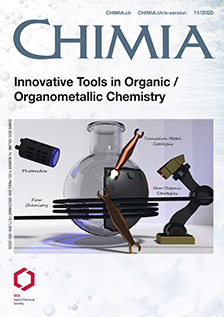Lithium-mediated Ferration of Fluoroarenes
DOI:
https://doi.org/10.2533/chimia.2020.866PMID:
33243321Keywords:
Cooperative bimetallics, Deprotonative metallation, Fluoroarenes, Iron, LithiumAbstract
While fluoroaryl fragments are ubiquitous in many pharmaceuticals, the deprotonation of fluoroarenes using organolithium bases constitutes an important challenge in polar organometallic chemistry. This has been widely attributed to the low stability of the in situ generated aryl lithium intermediates that even at –78 °C can undergo unwanted side reactions. Herein, pairing lithium amide LiHMDS (HMDS = N{SiMe3}2) with FeII(HMDS)2 enables the selective deprotonation at room temperature of pentafluorobenzene and 1,3,5-trifluorobenzene via the mixed-metal base [(dioxane)LiFe(HMDS)3] (1) (dioxane = 1,4-dioxane). Structural elucidation of the organometallic intermediates [(dioxane)Li(HMDS)2Fe(ArF)] (ArF = C6F5, 2; 1,3,5-F3-C6H2, 3) prior electrophilic interception demonstrates that these deprotonations are actually ferrations, with Fe occupying the position previously filled by a hydrogen atom. Notwithstanding, the presence of lithium is essential for the reactions to take place as FeII(HMDS)2 on its own is completely inert towards the metallation of these substrates. Interestingly 2 and 3 are thermally stable and they do not undergo benzyne formation via LiF elimination.
Downloads
Published
Issue
Section
License
Copyright (c) 2020 Lewis C. H. Maddock, Alan Kennedy, Eva Hevia

This work is licensed under a Creative Commons Attribution-NonCommercial 4.0 International License.







